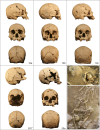Early Lapita skeletons from Vanuatu show Polynesian craniofacial shape: Implications for Remote Oceanic settlement and Lapita origins
- PMID: 26712019
- PMCID: PMC4720332
- DOI: 10.1073/pnas.1516186113
Early Lapita skeletons from Vanuatu show Polynesian craniofacial shape: Implications for Remote Oceanic settlement and Lapita origins
Abstract
With a cultural and linguistic origin in Island Southeast Asia the Lapita expansion is thought to have led ultimately to the Polynesian settlement of the east Polynesian region after a time of mixing/integration in north Melanesia and a nearly 2,000-y pause in West Polynesia. One of the major achievements of recent Lapita research in Vanuatu has been the discovery of the oldest cemetery found so far in the Pacific at Teouma on the south coast of Efate Island, opening up new prospects for the biological definition of the early settlers of the archipelago and of Remote Oceania in general. Using craniometric evidence from the skeletons in conjunction with archaeological data, we discuss here four debated issues: the Lapita-Asian connection, the degree of admixture, the Lapita-Polynesian connection, and the question of secondary population movement into Remote Oceania.
Keywords: Pacific Islands peopling; Polynesian origin; early Lapita; morphometric analysis; skull.
Figures





References
-
- Sheppard PJ, Chiu S, Walter R. Re-dating Lapita movement into Remote Oceania. J Pacific Archaeol. 2015;6(1):26–36.
-
- Bedford S. 2006. Pieces of the Vanuatu Puzzle: Archaeology of the North, South and Centre, Terra Australis 23 (Pandanus, Canberra, Australia)
-
- Bedford S, Clark G. 2001. The rise and rise of the incised and applied relief tradition: A review and reassessment. The Archaeology of Lapita Dispersal in Oceania, Terra Australis 17, eds Clark G, Anderson A, Sorovi-Vunidilo T (Pandanus, Canberra, Australia), pp 61–74.
-
- Hanihara T. Craniofacial continuity and discontinuity of Far Easterners in the Late Pleistocene and Holocene. J Hum Evol. 1994;27(5):417–441.
-
- Pietrusewsky M. The modern inhabitants of Island Southeast Asia: A craniometric perspective. In: Indriati E, editor. Recent Advances on Southeast Asian Paleoanthropology and Archaeology. Faculty of Medicine, Gadjah Mada University; Yogyakarta, Java: 2008. pp. 185–201.
MeSH terms
LinkOut - more resources
Full Text Sources
Other Literature Sources

